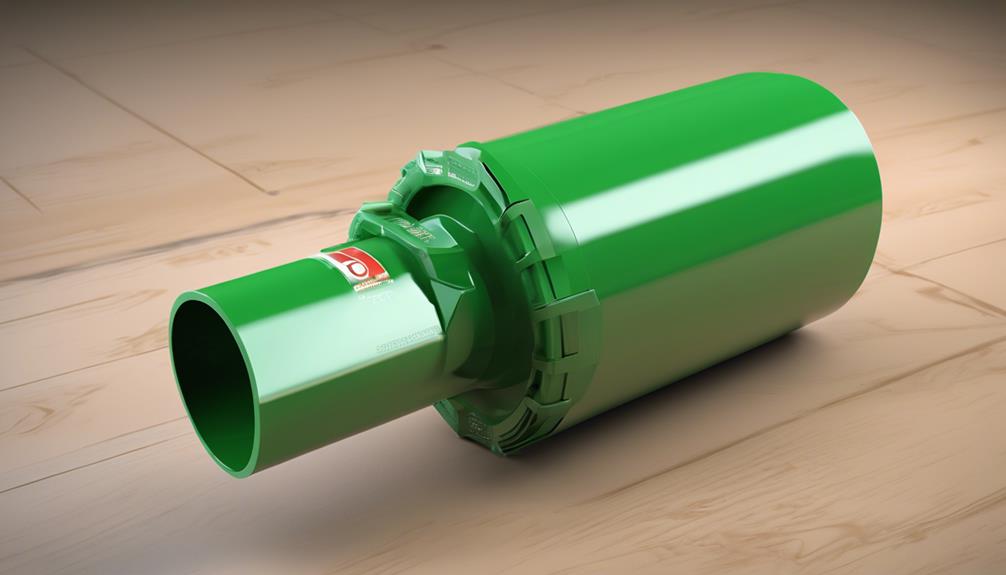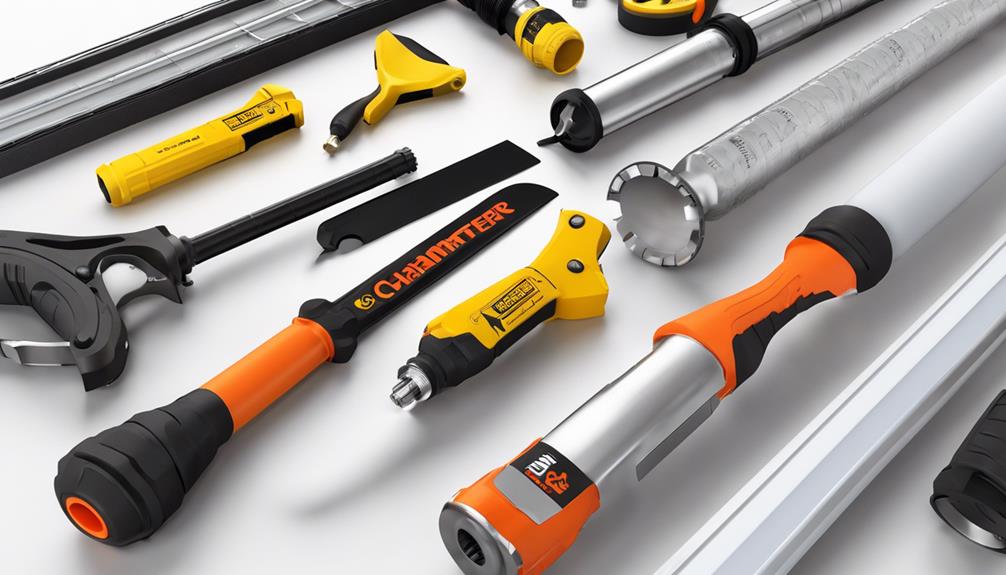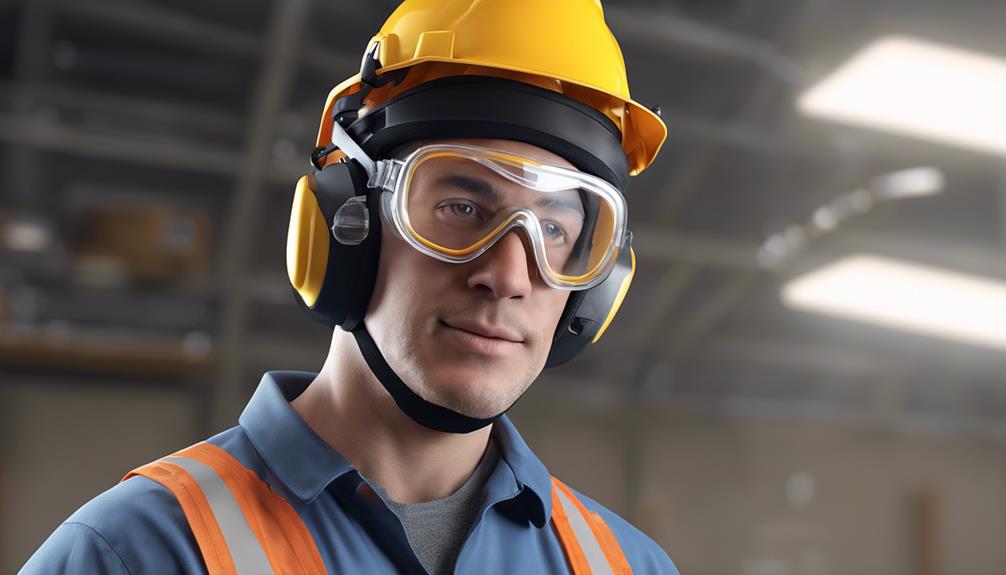When working with PVC piping, a PVC chamfer tool guarantees precise edges and minimizes leaks. Hold it perpendicular to the pipe's end, applying steady pressure while rotating for a clean finish. Avoid over-chamfering and follow guidelines for pro results. Chamfer tools come in various materials, custom designs, and compact options. Keep it clean, store securely to prevent rust, and check for wear regularly. Maintain safety with proper lighting, check for damage, handle with care, and wear protective gear. This tool is essential for quality installations and cost-saving practices.
Key Takeaways
- Ensures smooth PVC pipe edges for leak prevention and quality installations.
- Reduces joint failures and enhances aesthetics.
- Hold tool perpendicular to pipe end, rotate while applying firm pressure.
- Choose from various materials, sizes, and designs for different pipe diameters.
- Maintain tool by cleaning regularly, storing properly, and checking for wear.
Benefits of Using a PVC Chamfer Tool

Using a PVC chamfer tool guarantees smooth and precise edges on PVC piping, reducing the risk of leaks and improving overall installation quality. The tool efficiency of a PVC chamfer tool ensures that each edge is chamfered to the correct angle, preventing any sharp edges that could potentially damage seals or cause leaks. This professional finishing touch not only enhances the aesthetics of the installation but also contributes to its longevity by providing a secure and tight fit.
Cost savings are another significant benefit of using a PVC chamfer tool. By creating clean chamfered edges, the tool minimizes the likelihood of joint failures due to improper preparation. This can save you money in the long run by reducing the need for repairs or replacements.
Additionally, the time-saving benefits of a PVC chamfer tool can't be overstated. By streamlining the chamfering process, the tool allows for quicker and more efficient pipe preparation, ultimately speeding up the overall installation process.
How to Use a PVC Chamfer Tool
To properly utilize a PVC chamfer tool, begin by securely holding the tool perpendicular to the pipe's end. The chamfer tool should be positioned so that the blade is in direct contact with the outer edge of the pipe. Apply a firm, steady pressure as you rotate the tool around the pipe in a circular motion. This action will gradually shave off material from the pipe's edge, creating a smooth and beveled surface.
Proper technique is important when using a PVC chamfer tool to guarantee a clean and precise finish. Remember to maintain a consistent angle and pressure throughout the chamfering process to avoid uneven edges or damage to the pipe. Rotate the tool smoothly around the pipe to achieve a uniform chamfer on all sides.
Common mistakes when using a PVC chamfer tool include applying excessive force, which can lead to over-chamfering or even cracking the pipe. Additionally, inconsistent rotation or angle can result in an uneven chamfer that may affect the overall integrity of the joint. Be sure to follow the manufacturer's guidelines and practice proper technique to achieve professional results every time.
Types of PVC Chamfer Tools Available

When exploring the variety of PVC chamfer tools available, it's important to take into account the different designs and features tailored to specific pipe diameters and chamfering needs.
PVC chamfer tools come in various materials, including durable plastics, metals, and hybrid options. Each material offers unique benefits such as durability, corrosion resistance, and lightweight design.
Custom designs are another vital aspect to take into consideration when choosing a PVC chamfer tool. Some tools are specifically crafted for large diameter pipes, featuring wider chamfering blades and ergonomic handles for easier operation.
On the other hand, compact chamfer tools are designed for smaller pipes, providing precision chamfering in tight spaces.
Additionally, there are adjustable PVC chamfer tools that cater to different pipe sizes, offering versatility for various projects. These adjustable tools allow you to chamfer pipes of different diameters without the need for multiple tools.
Moreover, some PVC chamfer tools incorporate innovative features like quick-release mechanisms for swift blade changes, built-in deburring tools for added functionality, and built-in measurements for precise chamfer depths. These advanced features enhance efficiency and accuracy when chamfering PVC pipes.
Maintenance Tips for Your PVC Chamfer Tool
Properly maintaining your PVC chamfer tool guarantees peak performance and longevity in your pipe chamfering tasks. To make sure your tool stays in excellent condition, regular cleaning is essential.
After each use, wipe down the chamfer tool with a clean, dry cloth to remove any debris or residue. For more stubborn dirt or grime, use a mild detergent and water solution to clean the tool thoroughly. Avoid using harsh chemicals that could potentially damage the PVC chamfer tool.
When it comes to storing your PVC chamfer tool, it's important to keep it in a dry and secure place. Moisture can lead to rust or corrosion, impacting the tool's functionality. Consider storing the chamfer tool in a toolbox or a designated storage case to protect it from dust and potential damage.
Make sure the tool is stored away from direct sunlight or extreme temperatures, as these conditions can also affect its performance over time.
Regularly inspect your PVC chamfer tool for any signs of wear or damage. Look out for dull cutting blades or any loose parts that may need tightening.
Safety Precautions When Using a PVC Chamfer Tool

Maintain a clear workspace free of clutter and guarantee proper lighting when using a PVC chamfer tool to enhance safety during pipe chamfering tasks.
Before starting, make sure the tool is properly maintained. Check for any damage such as dull blades or loose parts that could pose a safety risk. It's important to handle the PVC chamfer tool with care. Always grip the tool firmly and securely to prevent accidental slips or drops that could lead to injuries.
When using the PVC chamfer tool, ensure to follow the manufacturer's instructions carefully. Improper handling can result in accidents and injuries. Avoid overexerting force when chamfering pipes as it can strain your muscles and lead to fatigue, increasing the likelihood of accidents.
Additionally, wear appropriate personal protective equipment such as safety goggles and gloves to safeguard yourself from any potential hazards. Make sure to keep your fingers and hands away from the cutting area to prevent accidental cuts or injuries.
After using the PVC chamfer tool, clean it thoroughly and store it in a safe place to prevent any damage or accidents in the future.
Conclusion
To sum up, utilizing a PVC chamfer tool offers numerous benefits such as smooth and clean cuts, increased efficiency, and reduced risk of injury.
By following proper maintenance tips and safety precautions, you can guarantee the longevity and effectiveness of your tool.
Remember to choose the appropriate type of PVC chamfer tool for your specific project needs to achieve best results.
